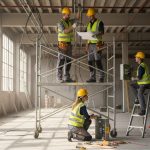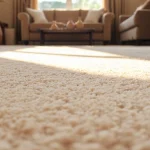Importance of CO2 Detectors in Terraced Homes
Recognising the importance of a CO2 detector is crucial for ensuring home safety in terraced houses. Carbon monoxide (CO), a colourless, odourless gas, poses significant health risks, including headaches, dizziness, and even fatality at high levels. Given that terraced homes often share walls and ventilation systems, the risks of CO accumulation can be higher compared to isolated homes.
CO2 detectors play a vital role in protecting residents from these dangers. They function by continuously monitoring CO levels in the air, sounding an alarm when dangerous concentrations are detected. Modern detectors come equipped with advanced technology such as digital displays and wireless connectivity, allowing easier monitoring and timely alerts. The significance of early detection cannot be overstated. It allows for prompt evacuation and intervention, minimizing the risk of CO poisoning.
Also to discover : Crucial safety guidelines for home electrical diy projects in the uk
Incorporating CO2 detectors in home safety plans ensures that terraced housing residents are aware of CO dangers. This approach not only safeguards individuals but also builds a safer community. Keeping detectors well-maintained and strategically placed enhances their effectiveness, providing a critical layer of defence against this invisible threat.
Key Guidelines for CO2 Detector Placement
Proper detector positioning is crucial for effective carbon monoxide detection in terraced homes. Following best practices ensures that residents receive timely alerts to potential hazards. In terms of ideal locations, detectors should be mounted on walls at a height of around 1.5 metres from the floor to align with human head level, maximising the chances of early detection.
Also read : Best-rated carpet cleaning providers in east kent for a spotless home
Compliance with UK safety standards is necessary for optimal protection. It is advised to place CO2 detectors near bedrooms and in rooms with fuel-burning appliances like kitchens or living rooms. Avoiding corners and ensuring placement at a distance from windows and exterior doors helps reduce false alarms and ensures accurate readings.
When considering height and distance, it’s important to note that mounting detectors on the ceiling should be at least 30 centimetres away from any wall. This consideration prevents ‘dead air space’, areas where gas might not circulate effectively, impacting the detector’s function.
Integral to home safety, these placement guidelines not only adhere to regulatory compliance but significantly increase the likelihood of successful CO2 detection. Following these guidelines ensures that CO warnings are timely, keeping occupants safe from this silent threat.
Factors Influencing Detector Placement
Understanding room characteristics plays a crucial role in determining the optimal placement of carbon monoxide detectors. The size and configuration of a room can significantly affect how carbon monoxide accumulates, thus influencing the detector’s effectiveness. Larger rooms may require multiple devices to ensure comprehensive monitoring, while smaller rooms may need fewer detectors.
Room Size and Configuration
The influence of room size on detector effectiveness is undeniable. Larger spaces may allow carbon monoxide to disperse more widely, potentially delaying detection by a single device. Conversely, smaller rooms might concentrate gases faster, necessitating rapid alerts. Therefore, it is critical to evaluate the dimensions and layout when deciding the number of detectors needed.
Airflow Patterns
Airflow considerations also impact how gases distribute throughout a room. Poor ventilation may lead to stagnant air, causing carbon monoxide to linger in specific areas. By installing detectors where airflow is optimal—away from corners or dead air spots—you can enhance the likelihood of early detection.
Presence of Potential CO Sources
Identifying potential carbon monoxide sources, such as fuel-burning appliances, is essential. Room characteristics, like appliances used, dictate where detectors should ideally be positioned, ensuring that they are near these potential CO sources to provide timely alerts.
Recommended Number of Detectors for UK Terraced Homes
Determining the number of detectors is essential for effective home safety. For most UK terraced homes, the layout dictates the required quantity. Typically, it is recommended to have at least one detector on each level of a multi-storey home. In addition, placing detectors near bedrooms and inside rooms housing fuel-burning appliances is ideal.
For homes with multiple floors or numerous rooms, it is prudent to position detectors in hallways leading to sleeping areas. This ensures maximum protection against carbon monoxide risks by alerting residents even during nighttime hours. Proper detector distribution across various areas helps in maintaining safety standards by providing comprehensive coverage.
Imagine a home where detectors are only in a single room. If carbon monoxide accumulates elsewhere, the risk of exposure increases dramatically. Therefore, balancing strategic detector placement across all critical areas enhances the chances of early detection, safeguarding the occupants effectively.
Abiding by these home safety guidelines not only aligns with UK safety standards but provides peace of mind. These considerations aim to enhance safety and minimise risks associated with inadequate carbon monoxide monitoring.
Visual Aids and Case Studies
Visual aids are invaluable for understanding the proper placement of CO2 detectors in terraced homes. Diagrams illustrating strategic detector positions can guide residents in optimizing home safety. Effective diagrams typically demonstrate placements near bedrooms, in rooms with potential carbon monoxide sources, and along escape routes. Incorporating these visuals ensures homeowners can easily visualize and implement best practices without guesswork.
Case Studies
Real-life case studies underscore the vital role of strategic CO2 detector placement. For instance, an incident in a terraced home where detectors were improperly placed resulted in delayed warnings, emphasising the necessity of adherence to guidelines. A contrasting example involved a home where strategically positioned detectors facilitated quick evacuation, showcasing the impact of comprehensive coverage.
Additionally, stories often highlight how detectors positioned according to UK safety standards and airflow considerations can prevent carbon monoxide poisoning. These anecdotes not only serve as cautionary tales but also provide practical insights into effective detector positioning.
By sharing these visual aids and real-life examples, residents can appreciate the tangible benefits of proper detector placement, inspiring confidence in the safety measures employed within their homes.
Additional Safety Tips and Resources
To ensure optimal safety, regular maintenance of CO2 detectors is paramount. Begin by scheduling routine checks, ideally monthly, to assess functionality and battery condition. Replacing batteries annually or when prompted by low-battery alerts maintains efficacy.
Testing detectors is a critical step. Most devices feature a test button; press it to ensure the alarm functions correctly. This practice guarantees that the system alerts you promptly in case of a carbon monoxide leak. Additionally, keep detectors dust-free and avoid painting them, as this may impair performance.
Keeping up-to-date with official safety resources empowers homeowners with the latest information. Consult organizations like the UK Health and Safety Executive (HSE) for detailed guidance on CO safety protocols. Staying informed about evolving safety standards ensures your home’s protective measures remain robust.
For further assurance, aligning with official safety guidelines offers peace of mind. Many resources provide valuable recommendations for both installation and maintenance. Familiarity with these guidelines not only promotes safety but bolsters confidence in handling potential CO threats effectively.









